Artificial Aging of Paper
Akilan R1 and Suneet Kumar2
1 Student of MSc Forensic sciences 2nd year, Galgotias University, India
2 Assistant Professor at Galgotias University, India
Submission:May 17, 2020; Published:June 08, 2020
*Corresponding author:Akilan R, Student of MSc Forensic sciences 2nd year, Galgotias University, Greater Noida, India
How to cite this article:Akilan R, Suneet K. Artificial Aging of Paper. J Forensic Sci & Criminal Inves. 2020; 14(1): 555879. DOI: 10.19080/JFSCI.2020.14.555879.
Abstract
Who will not be ready to pay a sum of money to acquire one of their favourite freedom fighter’s antique signed letter? But how genuine that letter might be? Is it really that old as it is claimed to be? Or is it fabricated by forgers? Artificial aging of paper is a method to imitate the paper’s natural aging process under simulated conditions to deceive someone. This study provides some basic tests and techniques to determine whether the claimed ‘aged’ document is really old or fabricated. The current study was done by analysing of the properties of the paper viz. colour, odour, texture, and examination under the microscope and Video Spectral Comparator to observe the fibre properties and influence of different light sources such as incident and transmitted UV, infrared, and monochromatic white light. This research yielded several observations that were different for artificially aged papers and naturally old papers. The results obtained thus tends to provide a document examiner with some preliminary tests to prove that the paper is naturally aged or artificially aged, and to differentiate between the two, before proceeding onto further expensive authentication methods such as PSA/DNA or JSA authentication techniques, ink analysis, and handwriting or typewriting analyses.
Keywords: Age of document; Artificial aging of paper; Paper staining; Dating of paper; Old documents
Abbreviations: VSC: Video Spectral Comparator; FTIR: Fourier Transform Infrared spectroscopy; PSA/DNA: In-the-presence authentication; JSA: James Spence Authentication
Introduction
As Albert S. Osborn mentioned in his book Question Documents, “No matter how suspicious the circumstances surrounding a fraudulent document, or how incredible the story of how it was found, or how generally improbable the alleged act may be, it usually becomes necessary first or last to prove the fraud, if it is to be proved at all, from the document itself. One of the first of the questions that naturally arise in such an inquiry is whether it is possible to show that a fraudulent document is not as old as it purports to be. This cannot always be done, but the question should always be investigated in a thorough, systematic manner. Questions of age enter into the study of disputed documents in many ways. Hundreds of thousands of dollars have been paid for spurious letters and writings of various kinds purporting to have been written by famous people. The most astonishing credulity is shown by purchasers of documents of this kind. These spurious papers are cherished with the greatest care, apparently with no suspicion that they were manufactured to be sold like certain imitation antique furniture.” (Osborn, 1910). Several experiments and tests were established to identify the age of documents scientifically. These methods include radiocarbon dating, FTIR spectroscopy. Other techniques can be the analysis of inks and their components to trace the time period of their origin, PSA/DNA or JSA authentication techniques, handwriting or typewriting analyses. Though there are some indirect and expensive tests available for the identification of age of a paper, there is no well-defined technique to differentiate an artificially aged document from a naturally aged document, so far. (Can we find absolute age of paper?, 2015). A proper standard will often open up an investigation that will lead to evidence of great value. Like the other studied previously researched regarding the age of the document, investigation of this matter of artificially aged document should be taken up and carried through following a definite routine in order that nothing may be overlooked, as mentioned by Osborn [1-6].
Case Studies
In the famous Hitler’s diary forgery case, a man named Konrad Kujau claimed that he possessed the diary of the notorious dictator Adolf Hitler, which he alleged to had been recovered from a crashed plane. The diary was sold to the Sunday Times magazine for about 3.7 million dollars, and several copies were printed. But later when subjected to forensic examination regarding the authenticity of its age, it was proved to have been forged and stained using nothing but tea. The paper analysis proved that it was forged between 1981-83, but was said to be written in the pre-war era in which that quality of paper was not yet manufactured. To manifest this, the diary sample was exposed to several complex chemical testing techniques and also signature analyses. It took a long time to prove the genuineness of its age, before which thousands of copies had already been sold in the market. Could there had been a much simpler technique to analyse the paper in order to find whether it is really old or forged, these losses could have been saved. Another famous case of the 1990s is of Leonore Carol “Lee” Israel,an American author known for committing literary forgery, by faking around 400 letters from deceased celebrities, including writers Noel Coward, Dorothy Parker, and Lillian Hellman, and sold them to literary dealers. Only if there was a cheaper method to be incorporated by the small-scale antique buyers, these forgeries could have been avoided. This study’s aim was to create artificially aged documents using various agents on different types of papers, to establish the general characteristics of those forged documents, and to prove that they are artificially aged [7-15].
Objectives
This research aims to determine the following
The general appearance before and after artificial aging
a. Colour
b. Texture
c. Brittleness
d. Patches
e. Edges
f. Fibre patterns
A. Odour change.
B. The most common characteristic observations found in all the artificially aged papers.
C. It is possible for someone to frame an authentic document holder by adding artificial agents on naturally old paper. Thus, to study the effects of those agents on naturally old papers.
D. Effects of discolouring agents like (water,vinegar,and bleach) on naturally old papers and artificially aged paper.
Materials and Methods
Preparation of artificially aged documents by using the following agents
a) Coffee solution-Coffee: water in a 3:1 ratio.
b) Soy Sauce solution dark Soy Sauce: water in a 1: 3 ratio.
c) Vinegar-Steel wool – Steel wool and iron rust soaked in vinegar for 3 weeks.
d) Lemon extract followed by hot ironing.
e) Oven Baking – 200° for 30 minutes.
f) Sun-drying – placed under sunlight for 4 weeks, followed by hot ironing.
Types of paper used
1) Bond paper – 21x15 cm
2) A4 (80 GSM) paper – 21x15 cm
3) Typewriting paper – 20x15.5 cm
4) Concrete paper – 21.5x17.5 cm
Analysing the artificially aged samples and the available naturally aged samples using
a. Visual analysis – Bright light source, shades chart for colour matching
b. Video Spectral Comparator – To view under different light sources, to view as a magnified image (x123)
c. Miscellaneous – Iron box, trays for drying, bleaching powder and vinegar, naturally old samples collected from known sources (e.g. Old record files, books, and diaries) Figure 1
Procedure
1. For each method of aging, several samples are created for each paper type.
2. The agents are applied to the papers using two methods
i. Dipping in the solution
ii. Brushing the solution
3. For methods like sun drying, baking, and ironing, appropriate procedures are used.
4. The samples are then subjected to various analysis techniques.
5. Observations are made and the results are inferred.
There is no single method that can exactly make a paper resemble a naturally old paper. Different types of paper used has differing results based on their reaction with different artificial aging agents [16-24]. Each paper type and their reaction with artificial agents, which resembles naturally old paper are plotted on pie charts Figure 2-6.
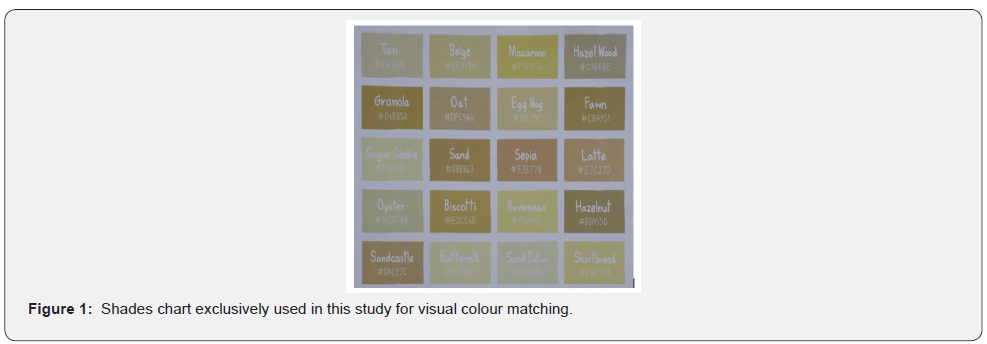
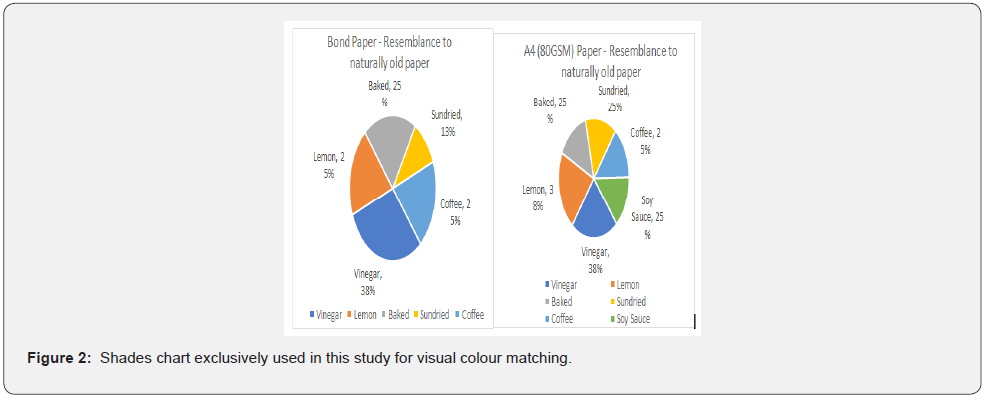

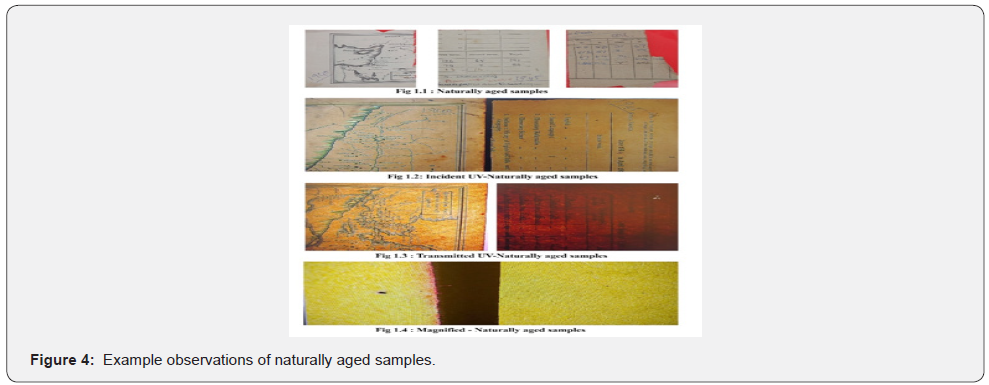
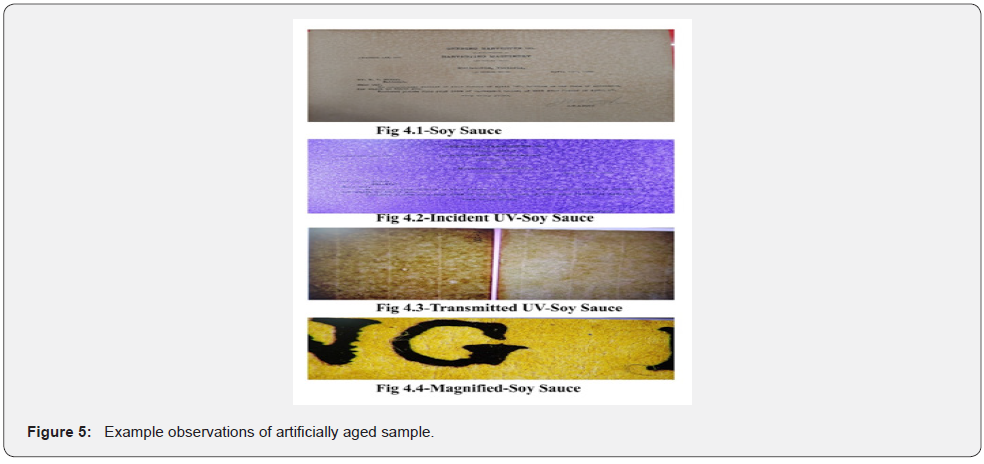

Conclusion
From this research study, it is confirmed that it is not possible to age a new paper in and out exactly like the naturally aged one. Instead, it is possible to forge a new paper exactly like a naturally aged paper, by appearance alone [26,27]. In that context, the differences between naturally aged and artificially aged samples are mentioned in Table 1 above, and they can be considered as the basic comparison factors to justify the genuineness of an acclaimed old document. On the contrary to the popular notion that expensive and complex techniques such as FTIR spectroscopy, radio-carbon dating, ink analysis, etc. are necessary to differentiate artificially and naturally aged papers. But the differentiation can be done with a few basic scientific examinations and techniques listed in this study. In a hypothetical situation, it is possible for someone to frame an authentic document holder by adding artificial agents on naturally old paper. In such cases, it is certain that these agents do have specific effects on the naturally old papers, but very superficially. Internally, these agents had negligible or no effect on the old papers. And when the samples were treated with certain simple discolouring agents such as water, vinegar, and bleach, the effect on papers was different depending upon the paper type and the artificial agent used on them from mild to complete whitening/ discoloration of the paper. This discoloration caused pertaining to the falsity of the age of the document is in contrast to the naturally aged documents in which no or negligible discolorations is observed. This can act as yet another identification technique to differentiate original and forged samples.
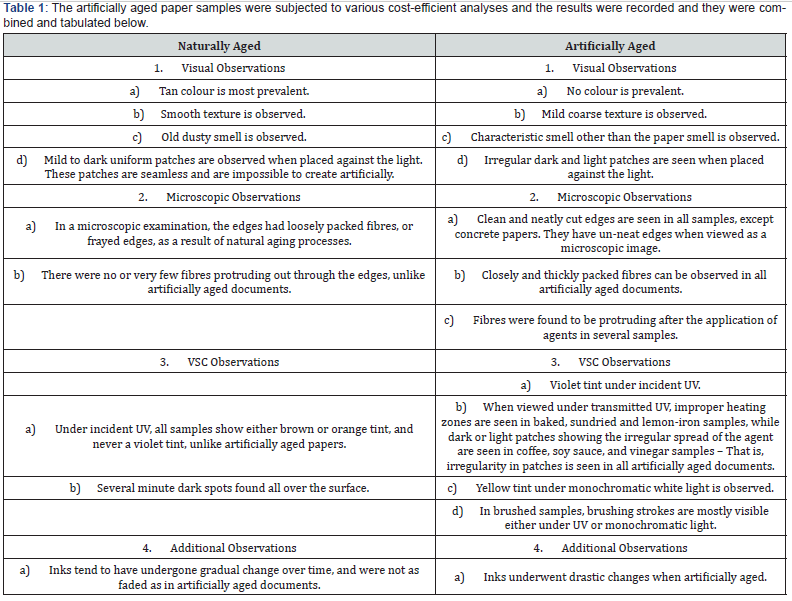
Finally, it is noted that not only the artificial aging agents are responsible for the changes in characteristics of the paper, but other factors such as the paper type, additional treatments like water or hot iron, and application method of agents also had a combined effect on the samples leading to its aged appearance.
References
- (2005) Sources in Paper Permanence Research.
- Area MC (2011) Paper aging and degradation.
- Arney, Chapdelaine (1979) Preservation of Paper and Textile of Historic and Artistic Value.
- Arney J (1979) Tappi Standards 62.
- Barrow W (1963) Virginia State Library.
- Baynes Cope (1976) International Biodeterioration and Biodegradation.
- Burney M (nd) Cellulose and Cellulose Derivatives part I.
- (2015) Can we find absolute age of paper? Retrieved from Research gate.
- Celine Weyermann E (2005) the potential of artificial aging for modelling of natural aging processes of ball point ink. Forensic Science International 180: 23-31
- Fellers C (1989) Ageing Degradation of Paper.
- Howard C (1964) Tappi Standard.
- L Michel, Baier P (1985) The Diaries of Adolf Hitler. Implication for Document Examination. Journal of Forensic Science Society 167-178.
- Lewis H (1945) Paper Trade.
- Lindstrom T (1989) Tappi Standard.
- Mendenhall (1977) Angewandte Chemie.
- Nol (1983) International Biodeterioration and Biodegradation.
- Nyrén K (1986) Library Journal.
- Osborn AS (nd) Questioned Documents.
- Page D (1969) Tappi Standards 52.
- Shahani C (1995) Accelerated Aging of Paper: Can It Really Foretell the Permanence of Paper.
- Stewart L (1982) Artificial Aging of Documents.
- Strzelczyk L (1981) International Biodeterioration and Biodegradation.
- Wessel (1970) The Library Quarterly.
- Wilson (1980) Restaurator
- Wilson, Parks (1983) Journal of Polymer Science part C
- Wilson, Harvey JL, Mandel J, Worksman TL (1955) Tappi Standards
- X Zou (1996) Prediction of paper permanence by accelerated aging. 243-267.






























